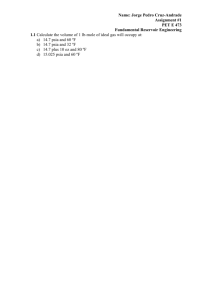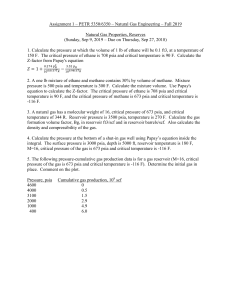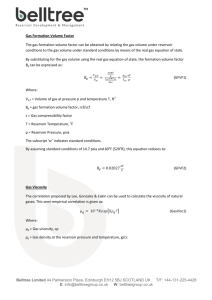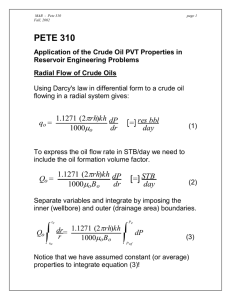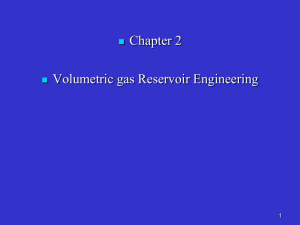Document
advertisement
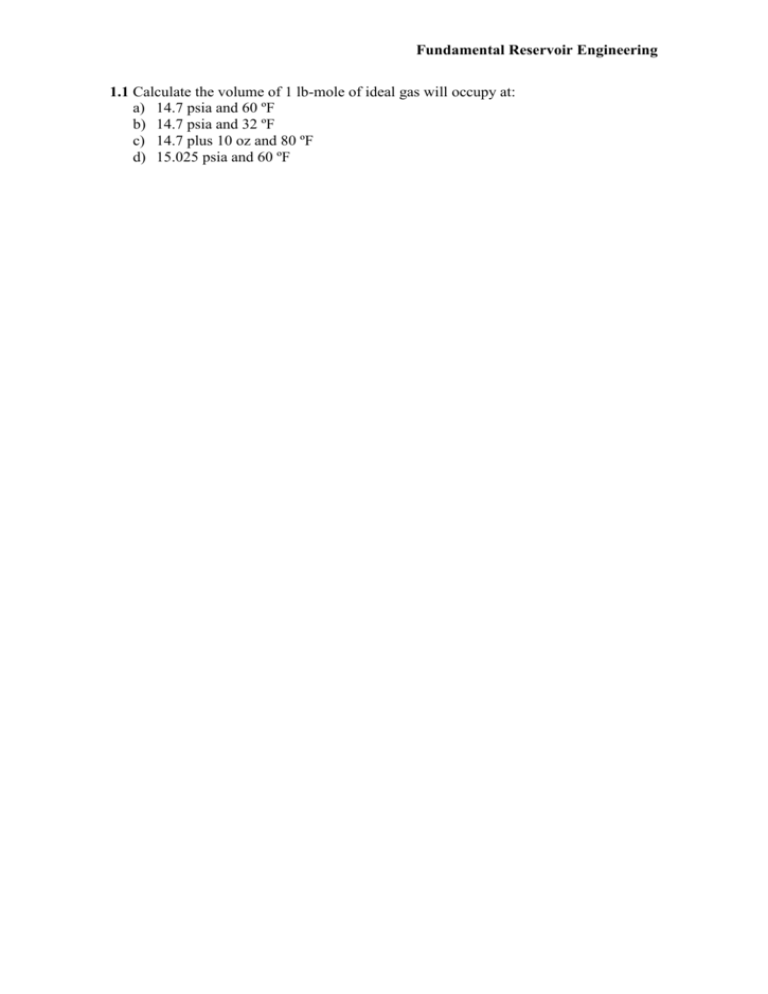
Fundamental Reservoir Engineering 1.1 Calculate the volume of 1 lb-mole of ideal gas will occupy at: a) 14.7 psia and 60 ºF b) 14.7 psia and 32 ºF c) 14.7 plus 10 oz and 80 ºF d) 15.025 psia and 60 ºF Fundamental Reservoir Engineering 1.2 A 500 cu ft tank contains 10 lb of methane and 20 lb of ethane at 90ºF a) b) c) d) How many moles are in the tank? What is the pressure of the tank is psia? What is the molecular weight of the mixture? What is the specific gravity of the mixture? Fundamental Reservoir Engineering 1.6 A 55,000 bbl (nominal) pipeline tank has a diameter of 110 ft and a height of 35 ft. It contains 25 ft of oil at the time suction is taken on the oil with pumps that handle 20,000 bbl per day. The breather and safety valves have become clogged so that vacuum is drawn on the tank. If the roof to withstsand 3/4 oz per sq in. pressure, how long will it be before the roof collapses? Barometric pressure is 29.1 in. Neglect the fact that the roof is packed and that there may be some leaks. Fundamental Reservoir Engineering 1.18 Experiments were made on a bottom-hole sample of the reservoir liquid taken from the LaSalle Oil Field to determine the solution gas and the formation volume factor as function of pressure. The initial bottom-hole pressure of the reservoir was 3600 psia, and bottom-hole temperature was 160 ºF; so all measurements in the laboratory were made at 160 ºF. The following data, converted to practical units, were obtained from the measurements: a) b) c) d) e) Pressure [psia] Solution gas [SCF/STB at 14.7 psia and 60 ºF] 3600 3200 2800 2500 2400 1800 1200 600 200 567 567 567 567 554 436 337 223 143 Formation Volume Factor Bbl/STB 1.310 1.317 1.325 1.333 1.310 1.263 1.210 1.140 1.070 What factors affect the solubility of gas in crude oil? Plot the gas in solution versus pressure. Was the reservoir initially saturated or undersaturated? Explain Does the reservoir have an initial gas cap? In the region of 200 to 2500 psia, determine the solubility of the gas from your graph in SCF/STB/psi. f) Suppose 1000 SCF of gas had accumulated with each stock tank barrel of oil in this reservoir instead of 567 SCF. Estimate how much gas would have been in solution at 3600 psia. Would the reservoir oil then be called saturated or undersaturated? Fundamental Reservoir Engineering 1.19 From the bottom-hole sample given in Prob 1.18 a) Plot the formation volume factor versus pressure b) Explain the break in the curve c) Why is the slope above the bubble-point pressure negative and smaller than the positive slope below the bubble-point pressure? d) If the reservoir contains 250 MM reservoir barrels of oil initially ¡, what is the initial number of STB in place? e) What is the initial volume of dissolved gas in the reservoir? f) What will be the formation volume factor of the oil when the bottom-hole pressure is essentially atmospheric if the coefficient of expansion of the stock tank oil is 0.0006 per F? Fundamental Reservoir Engineering 1.23 Estimate the viscosity of an oil at 3000 psia and 130 ºF. It has a stock tank gravity of 35 ºAPI and 130 ºF. It has a stock tank gravity of 35º API at 60 ºF and contains an estimated 750 SCF/STB of solution gas at the initial bubble point of 3000. Fundamental Reservoir Engineering 1.24 Given the following laboratory data: Cell Pressure (psia) 2000 1500=Pb 1000 500 14.7 Oil volume cell (cc) 650 669 650 615 500 Gas volume in cell (cc) 0 0 150 700 44,500 Cell Temperature (ºF) 195 195 195 195 60 Evaluate Rso, Bo, and Bt at the stated pressures. The gas deviation factors at 1000 psia and 500 psia have been evaluated as 0.91 and 0.95 respectively.

